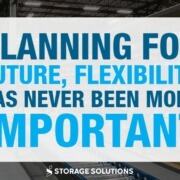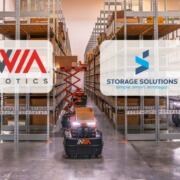Depending on your business cycle, planning comes at different times of the fiscal year. Typically, we see businesses planning for next year’s budget or big projects toward the second half of the year, especially in the third quarter (and sometimes, into the fourth).
However – as evidenced in almost every line of business – we are in a different world this year. Between the changing dynamics caused by COVID-19 and its variants, supply chain shortages, and fluctuating labor availability, planning for a flexible operational future has never been more critical.
Some of the common challenges that have affected the warehouse industry have been there for decades. Labor availability, rising prices, and material flow challenges have all been around for years. However, warehouses and distribution centers have been tasked with some unique challenges over the last two years, including the Amazon Effect’s dramatic rise, an incredibly volatile trade landscape, and unique labor challenges that started with the onset of COVID-19 in the United States.
At the core of finding solutions to these challenges is planning for flexibility in your operations. If there were a common thread among successful businesses amid the pandemic, it would be those who were dynamic, technologically adept, and those who maximized the value of their fulfillment operations. So, going into the next year or extensive set of projects, it stands to reason those companies will continue their success.
Steel prices are high, lead times are long, and that may not be changing soon.
According to Mining Technology, in July 2021, steel prices have been trading around 200% higher than during a pre-pandemic March 2020, and there isn’t any market movement to indicate price reductions until at least 2022. The report states, “Prices are expected to remain high due to the massive outstripping of demand vs. supply, and the time it will take for supply to catch up and replenish depleted steel stockpiles.”
So, not only is steel more expensive, but it is also more challenging for some companies to source materials; there is little inventory available. It helps to be a distributor of the size of Storage Solutions. Because we are the most significant storage equipment integrator in North America, we can leverage our unmatched partnerships with reserved production capacity programs for pallet racking, mezzanines, pick modules, and other equipment needs. However, just because we are more likely to source steel doesn’t necessarily mean it will be cheaper.
It is challenging to plan for a scenario like this. For example, let’s say you plan a project to start in a year, and the material price jumps 200% and cannot be guaranteed for delivery; what do you do? For us, it means our team of experts understands market forecasts like this, advises our partners on the best course of action early, and helps find the material they need to stick to their budget more closely. After all, when you’re building a three-level mezzanine with pick modules and vertical reciprocating conveyors and a 10% spike in pricing is coming, it is better to work with a partner who knows the market and can advocate action before that spike becomes 200%.
Labor challenges are real, expanding, and causing chaos in nearly every industry.
Suppose there is one common challenge among most companies in North America – if not the world – is the ever-evolving labor market. At the same time, labor challenges have been common in the warehousing industry for decades. However, during the same period in which warehouse managers are battling a volatile steel market and long lead times, they are also fighting “The Great Resignation.”
According to the U.S. Bureau of Labor Statistics, 2.7% of the entire U.S. workforce quit their jobs in July 2021, and a majority of these resignations took place in retail, professional services, transportation, warehousing, and utilities. The hope is that July 2021 was the peak of “The Great Resignation,” the term that refers to a rising turnover trend that arose in March 2020 with the start of COVID-19 spread in the U.S.
Some of the variables behind these trends are in a company’s control. There are elements like workplace conditions, benefits, flexibility, and more that can be managed to some degree. However, what happens when the competitor down the road can offer slightly better conditions or pay? What happens if another “Act of God” causes significant supply chain disruptions and strained conditions? How do you keep your business running if your employees can’t go to work?
At the same time, costs are also rising – not only with the actual labor rates and what is needed to complete order fulfillment. The operational costs go into recruiting, hosting job fairs, hiring, training (and then repeated if that process when the employee leaves). When those “soft” labor costs get added into the complete picture, then the situation becomes clear: you need to find a fix.
In terms of labor, planning for flexibility could mean a higher reliance on warehouse robotics and technology to solve these challenges. Solutions exist that can dramatically improve fulfillment rates while reducing dependence on human labor and lower costs. This environment doesn’t mean replacing your workers, only reducing your turnover. You can keep your best employees participating in higher-level tasks than walking around. For instance, inVia’s PickMate solution assists employees who are picking products by calculating the most efficient and accurate path to get products from storage to pack-out. This solution does not require an investment in infrastructure and can deliver an ROI on day one of implementation.
PickMate is just one example of the countless options that can improve aspects of your operation and better your bottom line. There are certainly systems out there that can enhance your operations. The best way to start is to work with an industry leader like Storage Solutions that takes an agnostic approach to find the best solution for you based on your operational needs and business goals.
So, what can you do to plan for flexibility in the future?
If you need some help determining how to move forward, give us a call. With our robust project management, creative design engineers, and network of manufacturing partners, we take most of the burden off of the planning process because we know all aspects of the project, from design to installation, through implementation and support.
Whether your challenges are sourcing material, designing material flow, labor challenges, or meet changing customer expectations, we can be there to assist in building out a roadmap that helps you reach your goals, both short-and-long-term. We’ve worked with companies along the distribution chain to develop simple, smart, and strategic solutions to their storage, picking & operational challenges.
While some of those challenges can be solved with active project management and responding reactively to problems, we take the correct approach – a proactive one – in recommending flexibility in developing your plans. Let’s get started today!





